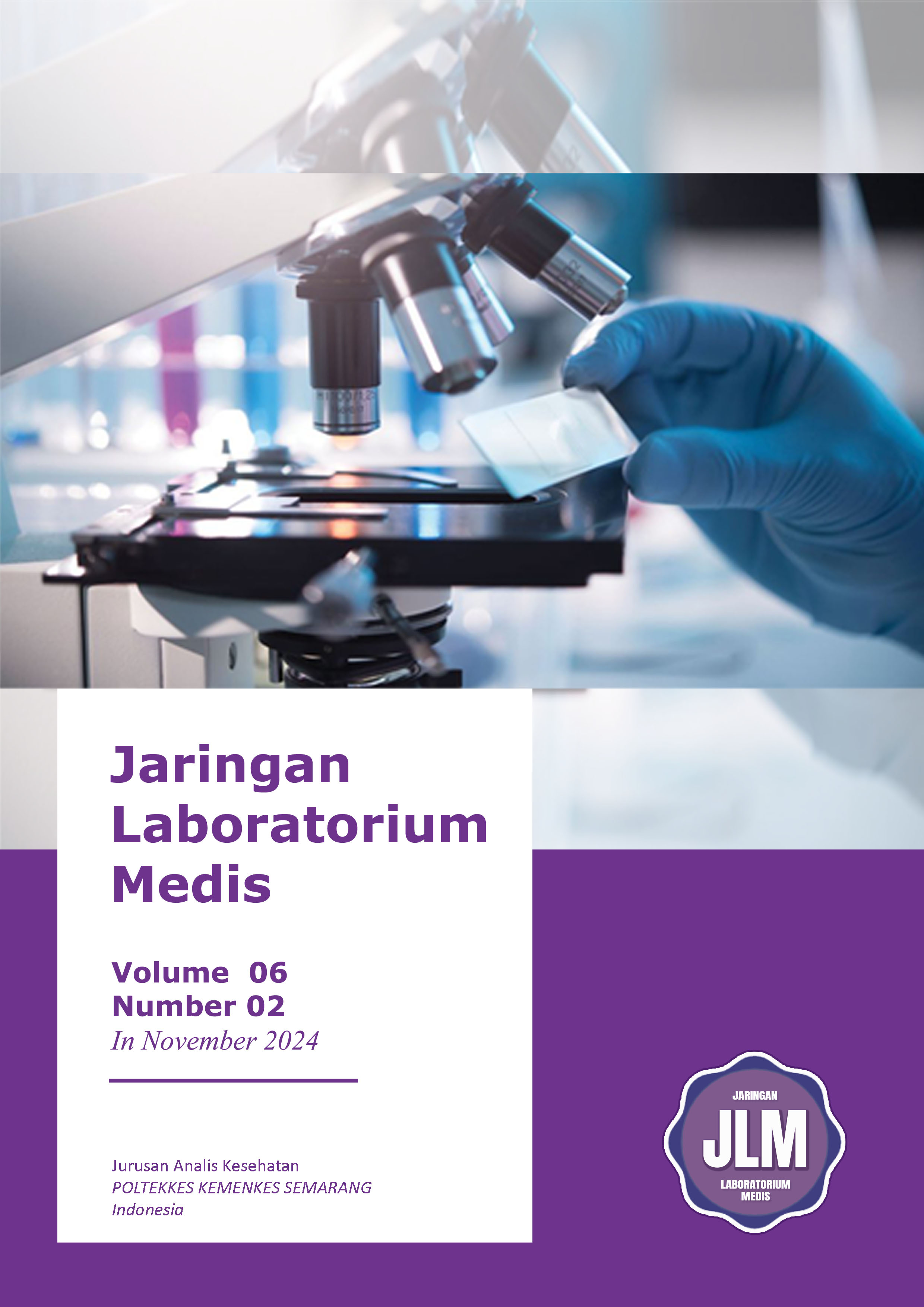Relationship Between the Incidence of Hypertension and Triglyceride Levels in Bus Drivers at Arjosari Terminal, Malang City
Published 2024-11-01
Keywords
- Hypertension,
- Triglycerides,
- GPO-PAP Method
Copyright (c) 2024 Jaringan Laboratorium Medis

This work is licensed under a Creative Commons Attribution-ShareAlike 4.0 International License.
How to Cite
CrossMark
Dimensions
If it doesn't Appear, click here
Impact Factor
Abstract
Hypertension is a health problem that is widely encountered in the community and correlates with other diseases. There are many factors that cause hypertension, one of which is abnormal triglyceride levels or hypertriglycerides. Higher levels of triglycerides will inhibit the occurrence of lipogenesis. Lipogenesis is a factor that causes hypertension from food intake, this is because food has a significant role in increasing blood pressure, especially protein and fat. This study aims to determine the relationship between triglyceride levels and hypertension. This type of research is an analytical research with the crosssectional method, statistical data analysis using correlation regression, the number of population as many as 50 respondents and the sample used as many as 21 respondents. Data collection using questionnaires, blood pressure measurements and triglyceride level checks. Blood pressure measurement is done manually and then for the examination of triglyceride levels using the GPO-PAP method is carried out in the laboratory of the Bareng Health Center using a spectrophotometer. The statistical analysis used is the correlation Pearson test. The results of the study on bus drivers with high blood pressure showed that some respondents had high triglyceride levels because they often ate fatty foods. Based on the examination that has been carried out on 21 bus driver respondents at the Arjosari Terminal, Malang City, it shows that triglyceride levels and high blood pressure have no relationship, with the test results using the Pearson correlation statistical test obtained a result of P=0.0766 >0.05 with a Pearson value of P=-0.069 correlation meaning that it does not have a relationship with the degree of very weak relationship.
Downloads
References
- Agustina, R., & Raharjo, B. B. (2020). Faktor Risiko Yang Berhubungan Dengan Kejadian Hipertensi Usia Produktif (25-54 Tahun). Unnes Journal of Public Health, 4(4), 146–158. https://doi.org/10.15294/ujph.v4i4.9690
- Aini, N., Khasanah, H., Setiyawati, M., & Bus, S. (2020). Hubungan Durasi Tidur Dengan Kadar Trigliserida Risiko Penyakit Jantung Koroner Dan Pembuluh Darah ( Sawant Et Al ., 2020 ). Kadar Trigliserida Normal Dalam Darah Adalah Sedangkan Trigliserida Atau Memiliki Nama Lain Triasilgliserol Merupakan Salah Satu J. 122–131.
- Dinkes. (2022). Profil Kesehatan Kota Malang Tahun 2022. Profil Kesehatan Malang.Https://Dinkes.Malangkota.Go.Id/Wp-Content/Uploads/Sites/104/2023/08/Profilkes-Kota-Malang-2022.Pdf
- Djafar, M. &. (2021). Konsep Hipertensi. Gastronomía Ecuatoriana y Turismo Local., 1(69), 5–24.
- Febriyanti, M., Sulistyani, S., Mahmudah, N., & Rosyidah, D. U. (2021). Hubungan Antara Kadar Trigliserida Dan Hipertensi Terhadap Lamanya Rawat Inap Pasien Stroke Iskemik. Proceeding Book National Symposium and Workshop Continuing Medical Education XIV, 889–901.
- Hardisari, R., & Koiriyah, B. (2021). Gambaran Kadar Trigliserida (Metode Gpo-Pap) Pada Sampel Serum dan Plasma EDTA. Jurnal Teknologi Laboratorium, 5, 27–31.
- Iii, B. A. B., Jenis, A., & Penelitian, D. (2014). 30 Poltekkes Kemenkes Yogyakarta. September 2019, 30–41.
- Kusnan, A. (2022). Pengaruh Teh Hijau Dalam Menurunkan Tekanan Darah: Systematic Review. NURSING UPDATE: Jurnal Ilmiah Ilmu Keperawatan P-ISSN: 2085-5931 e-ISSN: 2623-2871, 13(1), 69–79.
- Laurensia, L., Destra, E., Saint, H. O., Syihab, M. A. Q., & Ernawati, E. (2022). Program Intervensi Pencegahan Peningkatan Kasus Hipertensi Di Wilayah Kerja Puskesmas Sindang Jaya. E-Amal: Jurnal Pengabdian Kepada Masyarakat, 2(2), 1227–1232. https://doi.org/10.47492/eamal.v2i2.1472
- Manikam, C. G., Tulus, A., & Santosa, B. (2022). Perbedaan Hasil Pemeriksaan Kadar Trigliserida Sampel Serum Dan Plasma EDTA. PhD Thesis Muhammadiyah University of Semarang, 8–25.
- Niland, N., Pearce, A. P., Naumann, D. N., O’Reilly, D., Series, P. B., Sataloff, R. T., Johns, M. M., Kost, K. M., Orsini, R. J., Medicine, T., Kalkman, J. P., Sataloff, R. T., Johns, M. M., Kost, K. M., Maiti, Bidinger, Assistance, H., Mitigate, T. O., Eroukhmanoff, C., & Licina, D. (2020). metabolisme trigliserida dalam darah. Global Health, 167(1), 1–5. https://www.e-ir.info/2018/01/14/securitisation-theory-an-introduction/
- Pravitasari, H. F., Mahmuda, I. N. N., Jatmiko, S. W., & Nursanto, D. (2021). Hubungan Tekanan Darah, Kolestrol Total dan Trigliserida terhadap Pasien STEMI dan NSTEMI. PublikasiIlmiahUMS,243–256. https://publikasiilmiah.ums.ac.id/xmlui/handle/11617/12632
- Silmi, S. (2021). Metoda Penelitian. Bab III Metoda Penelitian, Bab iii me, 1–9.
- Te’ne, C. A., & Karjadidjaja, I. (2020). Hubungan overweight dan obesitas terhadap hipertensi pada pengemudi bus antar kota PT GM Jakarta. Tarumanagara Medical Journal, 2(1), 14–19. https://doi.org/10.24912/tmj.v2i2.7831
- Tresia, Y. (2022). Gambaran Trigliserida Pada Mahasiswa Obesitas Pengonsumsi Junk Food Systematic Review Yohana Tresia Pasaribu Prodi D-Iii Jurusan Teknologi Laboratorium Medis Politeknik Kesehatan Kemenkes Medan Tahun 2022.

